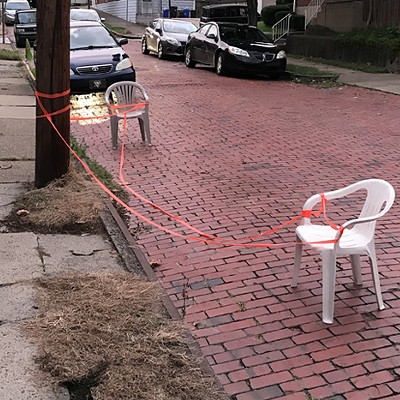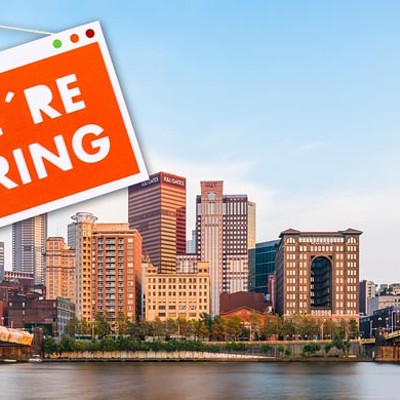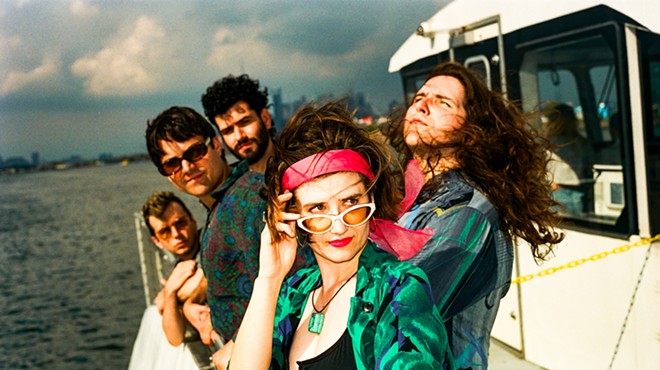At one time, the best thing the Mon Valley had going for it was that everyone wanted to talk about Braddock Mayor John Fetterman. But now, perhaps, it might be better if everyone stopped.
In recent years, the tattooed 6-foot-8-inch mayor drew notice from outlets like Rolling Stone, The New York Times, The Colbert Report and the CBS Evening News. The stories lauded his initiative to invite artists, urban-agriculturalists and other pioneers who could help reverse the struggling town's collapse. Fetterman became a spokesman for investing in renewable energy; his town has become the rusted, and oddly rustic, backdrop for a Levi's blue-jeans ad campaign.
Which made Sue Halpern's Feb. 13 New York Times Magazine piece inevitable. Sooner or later, someone was bound to wonder why, despite all the hoopla, only fewer than three dozen people have actually moved into Braddock.
Halpern introduces us to one artist who came to Braddock expecting to find "an artist's compound" after being "a little blinded by the image of Braddock that has been portrayed in the media." Others have sunk their life savings into fixing homes that were only supposed to cost $5,000. Of one long-term resident, meanwhile, Halpern writes that despite all Fetterman's success at importing socially conscious artists and beehives, nothing "has changed the most essential facts of his life: he is poor and without prospects."
But really, how could it? Fetterman's done a lot of good, but he's always been upfront about the challenges Braddock faced. Did we really think that beehives and green roofs could reverse decades of suburban sprawl and free-market excess? And if not, why did national media give them so much ink in the first place?
Some of it was the visuals: Fetterman has Braddock's zip code tattooed on his arm, and it's no accident that the Atlantic Monthly put his imposing bald head on the cover of its November 2009 issue. "I look like a washed-up professional wrestler, and that generates interest," Fetterman acknowledges.
Then there's the simply lemming-like behavior of the national press, whose reporters constantly chase each other's stories. A journalist looking for new tales of hardship wouldn't have to stray too far from the path: According to Census Bureau estimates, of the 10 most-impoverished municipalities in Allegheny County, nine were in Braddock's vicinity of the Mon and Turtle Creek valleys. Those other places haven't gotten so much as a Geico ad.
But even Braddock -- which unlike other Mon Valley towns had the good fortune to elect a charismatic, tattooed Harvard grad with family money to invest -- may be the exception that proves the rule. Its decline is often ascribed to the "collapse of the steel industry," but its population decline began during steel's glory years, when 1950s prosperity induced a generation of American workers to go forth into the suburbs.
We are all workers, as the Levi's ad would have it. And we all turned our backs on Braddock, and places like it. So when a guy offers a marketing-friendly urban-renewal proposal -- turn urban decay into an asset! reverse capitalist excess with entrepreneurial know-how! -- it's no wonder we can't stop reading. We want to believe John Fetterman can pull off a miracle ... so no one else has to bother. And if he fails, someone else stands to blame.
For the record, Fetterman blames Halpern's article for focusing too heavily on a small group of critics, some of whom don't even live in the borough. Still, I came away from the piece thinking the problem isn't Fetterman but the constraints he faces -- like antiquated boundaries that fracture Mon Valley governments into tiny, ineffective fiefdoms that can do little more than squabble among themselves. (Fetterman himself refuses to attend borough council meetings -- part of a running dispute with the council majority.)
"Wherever I go, I tell people this isn't easy," Fetterman says. And with all the deficit-reduction talk in Washington, it will only get harder. "I've got people in this town who don't have heat, and our Democratic president is talking about cutting heating-assistance programs."
That's nothing an art gallery is going solve, and it's not the sort of thing national magazines worry about. But maybe someone in McKeesport could put it on a tattoo.














